Related Research Articles
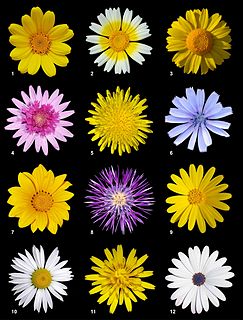
Asteraceae or Compositae, is a very large and widespread family of flowering plants (Angiospermae).
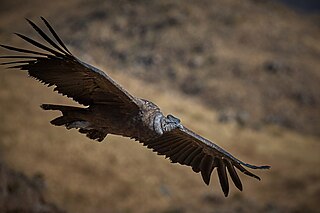
The Andean condor is a South American bird in the New World vulture family Cathartidae and is the only member of the genus Vultur. Found in the Andes mountains and adjacent Pacific coasts of western South America, the Andean condor is the largest flying bird in the world by combined measurement of weight and wingspan. It has a maximum wingspan of 3.3 m exceeded only by the wingspans of four seabirds and water birds—the roughly 3.5 m maximum of the wandering albatross, southern royal albatross, great white pelican and Dalmatian pelican.

Helianthus is a genus of plants comprising about 70 species. Except for three species in South America, all Helianthus species are native to North America and Central America. The common names "sunflower" and "common sunflower" typically refer to the popular annual species Helianthus annuus, whose round flower heads in combination with the ligules look like the sun. This and other species, notably Jerusalem artichoke, are cultivated in temperate regions and some tropical regions as food crops for humans, cattle, and poultry, and as ornamental plants. The species H. annuus typically grows during the summer and into early fall, with the peak growth season being mid-summer.
Ericentrodea is a genus of South American flowering plants in the sunflower family.
Pappobolus is a genus of flowering plant in the sunflower family native to the Andes Mountains of Colombia, Ecuador, and Peru.

Viguiera is a genus of flowering plants in the sunflower family, Asteraceae. The name honours French physician L. G. Alexandre Viguier (1790–1867). It contains around 150 species, which are commonly known as goldeneyes and are native to the New World. These are herbs to bushy shrubs that bear yellow or orange daisy-like flowers.
Brickelliastrum is a North American genus of flowering plants in the tribe boneset tribe within the sunflower family. Brickelliastrum has at times been lumped with Brickellia or Steviopsis, but chromosome number (x=10) and molecular data are in agreement in showing that it is distinct from either of these. Despite having the general appearance of Brickellia, members of Brickelliastrum have cypselae that have only 5-7 ribs, funnel-shaped corollas, and a style with an unenlarged, glabrous base.
Ferreyrella is a genus of Peruvian flowering plants in the sunflower family.
Steviopsis is a genus of Mexican plants in the boneset tribe within the sunflower family.

Aldama is a genus of flowering plants in the daisy family. The genus was originally described to include one species of subtribe Helianthinae that were characterized by having pales that tightly enclosed the cypselae (achenes). Recent molecular phylogenetic studies showed that these species are within a large group that were formerly classified in the genus Viguiera, and Aldama has been expanded to include a total of 118 species. Aldama is characterized by having a perennial herbaceous habit, a pappus usually of awns and scales, and a multiseriate involucre.
Alvordia is a genus of flowering plants in the family Asteraceae. It includes 4 species of shrubs which occur in the states of Baja California and Sonora, Mexico. The genus is characterized by having a secondary clustering of heads into compound units, so that what appears to be a single head is actually a group of heads packed together. The genus is classified as a member of subtribe Helianthinae, the same subtribe that contains the common sunflower (Helianthus). Based on the reported chromosome counts, Alvordia includes both diploid and polyploid species, but the relationships among these have not yet been studied in detail. No chromosome count has yet been reported for the species A. congesta from Sonora, which was a later transfer to the genus.
Hymenostephium is a genus of flowering plants in the family Asteraceae. It includes herbs and slender shrubs that occur from Mexico through Central America and into South America.
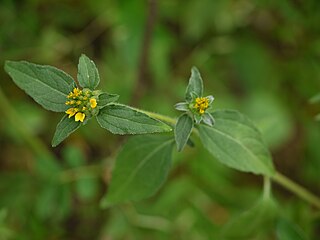
Sclerocarpus is a genus of flowering plants in the sunflower tribe within the daisy family. Bonebract is a common name for plants in this genus.
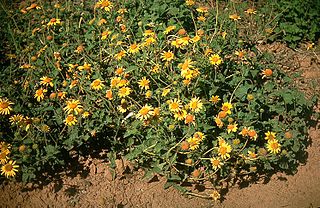
Simsia is a genus of flowering plants in the sunflower tribe within the daisy family. It includes annuals, herbaceous perennials, and shrubs. They range from the western United States south through Central and South America to Argentina, with the center of diversity occurring in Mexico. The genus is named for British physician and botanist John Sims (1749–1831). Although some species are relatively rare, others have become common weeds that line the roadsides and fields of Mexico, often forming dense stands mixed with Tithonia and other Asteraceae. Some species are known by the common name bushsunflower.

Iostephane is a genus of Mexican flowering plants in the sunflower family.
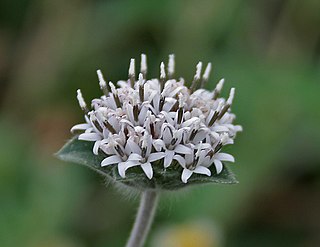
Lagascea is a genus of flowering plants in the family Asteraceae. It occurs primarily in Mexico, but some species extend into Central America and one reaches north into the western United States. One species, L. mollis, has been widely introduced to other localities around the tropics and subtropics.
Oyedaea is a genus of South American flowering plants in the sunflower tribe within the daisy family.

Perymenium is a genus of South American and Mesoamerican plants in the sunflower tribe within the daisy family.

Podachaenium is a genus of Mesoamerican plants in the sunflower tribe within the daisy family.

Gymnarrhenoideae is a subfamily with in the daisy family, with only one tribe, the Gymnarrheneae. Two very different species have been assigned to it, Gymnarrhena micrantha, a winter annual from the deserts of North-Africa and the Middle-East, and Cavea tanguensis, a perennial herb that grows on scree near streams and glaciers in the Eastern Himalayas. These species have very little in common, other than having two types of flower heads and sharing a tendency towards dioecism. Both also have basal leaf rosettes, stretched leaves, with few spaced teeth on the margin, and both lack spines and latex.
References
- 1 2 Flann, C (ed) 2009+ Global Compositae Checklist
- ↑ Blake, Sydney Fay. 1916. Botanische Jahrbücher für Systematik, Pflanzengeschichte und Pflanzengeographie 54(part 3, issue 119): 49-51 descriptions in Latin, commentary in English
- ↑ Tropicos, Syncretocarpus S.F. Blake
- ↑ Panero, J. L. and A. G. Paucar. 2005. A new species of Syncretocarpus (Asteraceae: Heliantheae: Helianthinae) from Central Peru. Phytologia 87: 110-113.
| This Heliantheae article is a stub. You can help Wikipedia by expanding it. |